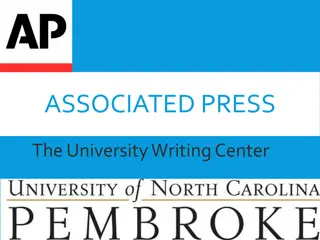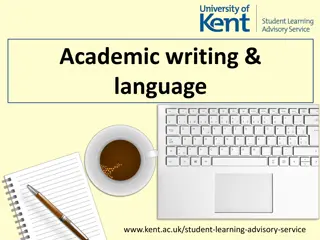Mastering Style Guides for Effective Writing
Dive into the essence of style guides and their importance in establishing consistency and clarity in written content. Explore the various elements covered in a style sheet, from punctuation preferences to language variations, to enhance your writing skills and ensure coherence in communication.
Download Presentation

Please find below an Image/Link to download the presentation.
The content on the website is provided AS IS for your information and personal use only. It may not be sold, licensed, or shared on other websites without obtaining consent from the author.If you encounter any issues during the download, it is possible that the publisher has removed the file from their server.
You are allowed to download the files provided on this website for personal or commercial use, subject to the condition that they are used lawfully. All files are the property of their respective owners.
The content on the website is provided AS IS for your information and personal use only. It may not be sold, licensed, or shared on other websites without obtaining consent from the author.
E N D
Presentation Transcript
ACP2070 Editing Principles and Practice 2014 Lecture 6 Style
A Style Guide: rules or conventions set out by a publishing house, journal or press outline the correct approach to take to questions of style which are questions of preference and choice rather than grammatical or linguistic necessity (i.e. where there is not a straightforward right' or wrong' decision). also called house style', the company's or press's style.
Things covered by the term style guide' include: House style' Author's style guide Style sheet The particular Australian Style Manual you are using in this course.
What sorts of things might a style sheet cover? Foreign words and accents eg. Caf Single or double quotation marks Footnote and endnote style Maximal or minimal capitalisation Australian or American spelling Preferred choice in alternative spellings - inquiry or enquiry? Ageing or aging? Coined terms and slang, swear words. Dates (24 July 2008 or July 24, 2008?)
Hyphenation - co-operation or ad-hoc Abbreviations Structure and consistency for items in a list unusual or invented terms such as droog' or muggle' - as is, within quote marks, or in italics. numbers or sets of statistics - appear as words (ten) or numerals (10) and whether these rules change depending on the frequency or size of the numbers Typographical decisions - whether ellipses will be spaced and what sort of dash to use.
Mum's a nagger even if she loves me. She reckons Shelley's a bogan who only cares about catching the perfect pipe. But Shelley's ace and I'm thinking whatever.com Mum's a nagger even if she loves me. She reckons Shelley's a bogan who only cares about catching the perfect pipe . But Shelley's ace and I'm thinking whatever.com
Particular style questions or language usage? An academic journal A street music press A government publication A young adult novel A French cookery book?
While English has this richness and capacity for subtlety it also contains the bases for innumerable disagreements about usage. Various substantial etymological roots - Latin, Norman French, Old English. See p 76 MacKenzie) A variety of places and cultures where English has followed its own path. The rise of Chinglish. Two hundred years of cultural and linguistic exchange between the outposts of the English empire which has further confused the matter.
The validity of our historical and etymological justifications Consistency Audience Practical outcome
Abbreviations, Acronyms & Initialisms (see Style Manual p150-62) Qld Tas. WA/Western Australia VU/Victoria University QANTAS 1. audience familiarity 2. aesthetic considerations
Capital Letters (the Style Manual has some rules on government titles, p. 124) Proper names and when do capitals disappear from proper names? Official titles Geographical names Unique historical events Scientific terms Commercial names/trademarked brands (Venetian blinds, HarperCollins)
Apostrophes In Australian English we never use an apostrophe to signal the plural: - 2000's
Possessive The teacher's lectures The teachers' lectures What do we do when a singular possessive noun ends with an s?
The usual rule is to add s but some surnames ending in s may occasionally be an exception to this depending on the sound. The below examples concern names ending in s . s-sound: Mr Lewis's opinion z-sound: Davy Jones' Locker Singular possessive nouns that end in s and that are not names will always require an apostrophe and an s (the boss s car). Plural possessive nouns ending in s only require an apostrophe (the bosses happiness, the workers' revolution).
Contractions don't won't could ve should ve
Italics Emphasis Foreign words acclimatisation Not naturalised - Je ne sais quoi Naturalised - status quo, de facto Do we use them for books and magazines? Newspapers? the Age , or The Age ? the Australian, The Times?
Numbers When do we spell them out/ use numerals? Depends on the kind of publication. In texts where very few numbers are used it is just as well to spell them out. Threshold becomes important when a text uses many words. Difficulty when numbers in one sentence are above and below the threshold. Never start a sentence with a figure rewrite. What about: 1984 is the most important book of the twentieth century.
Style sheet Is put together on a job-by-job basis. It is meant to cover anything that is subject to variation from house style or is not covered by house style. It is also meant to ensure consistency in an author's usage.
Even in the course of today's lecture I've had to make many tiny decisions of style: Do I make textbook one word or two or hyphenated? Do I italicise the' in the name of the Style Manual ? Am I using smart or straight quotes? Do I want my lists to be full sentences or not?
























